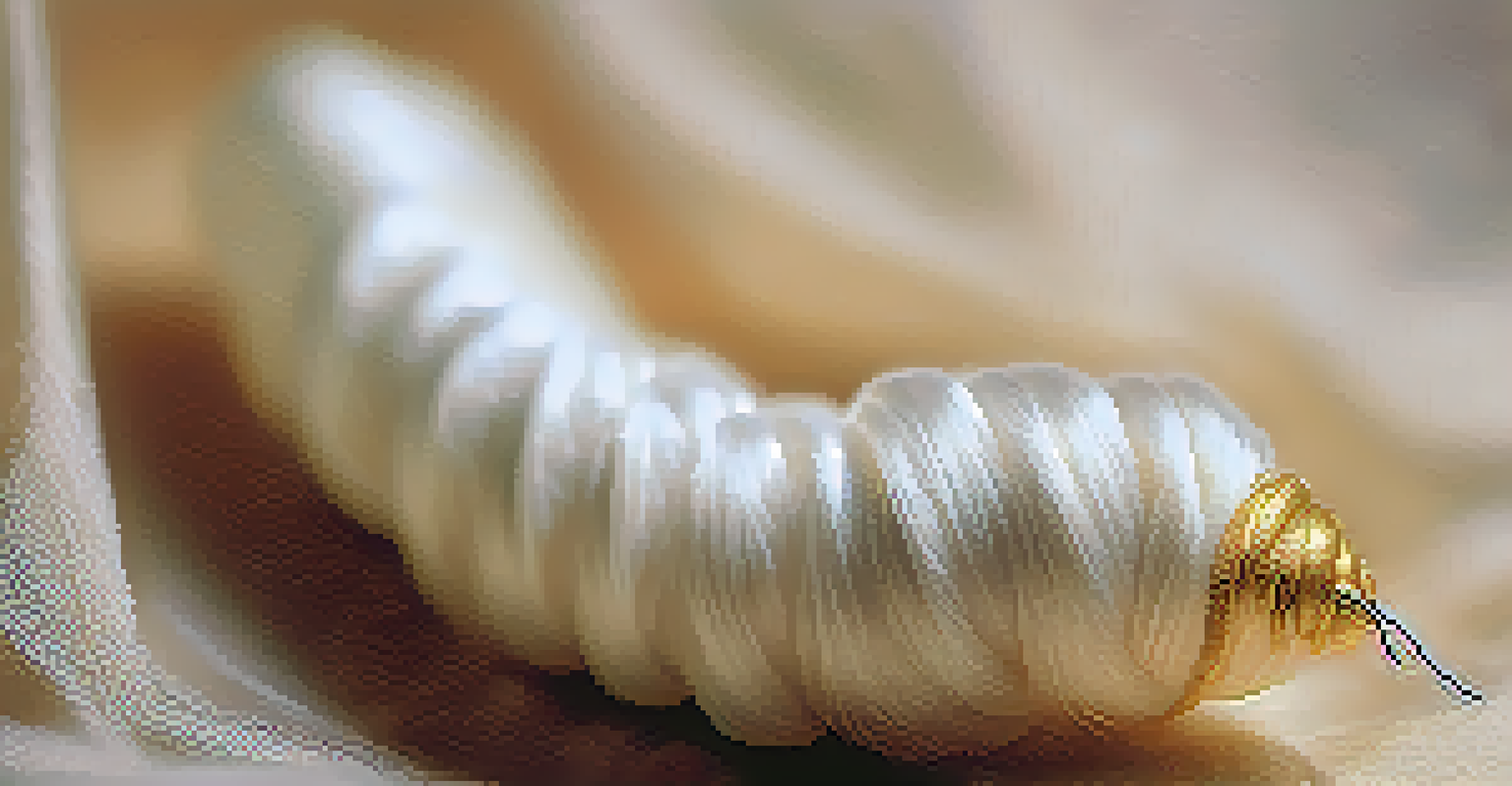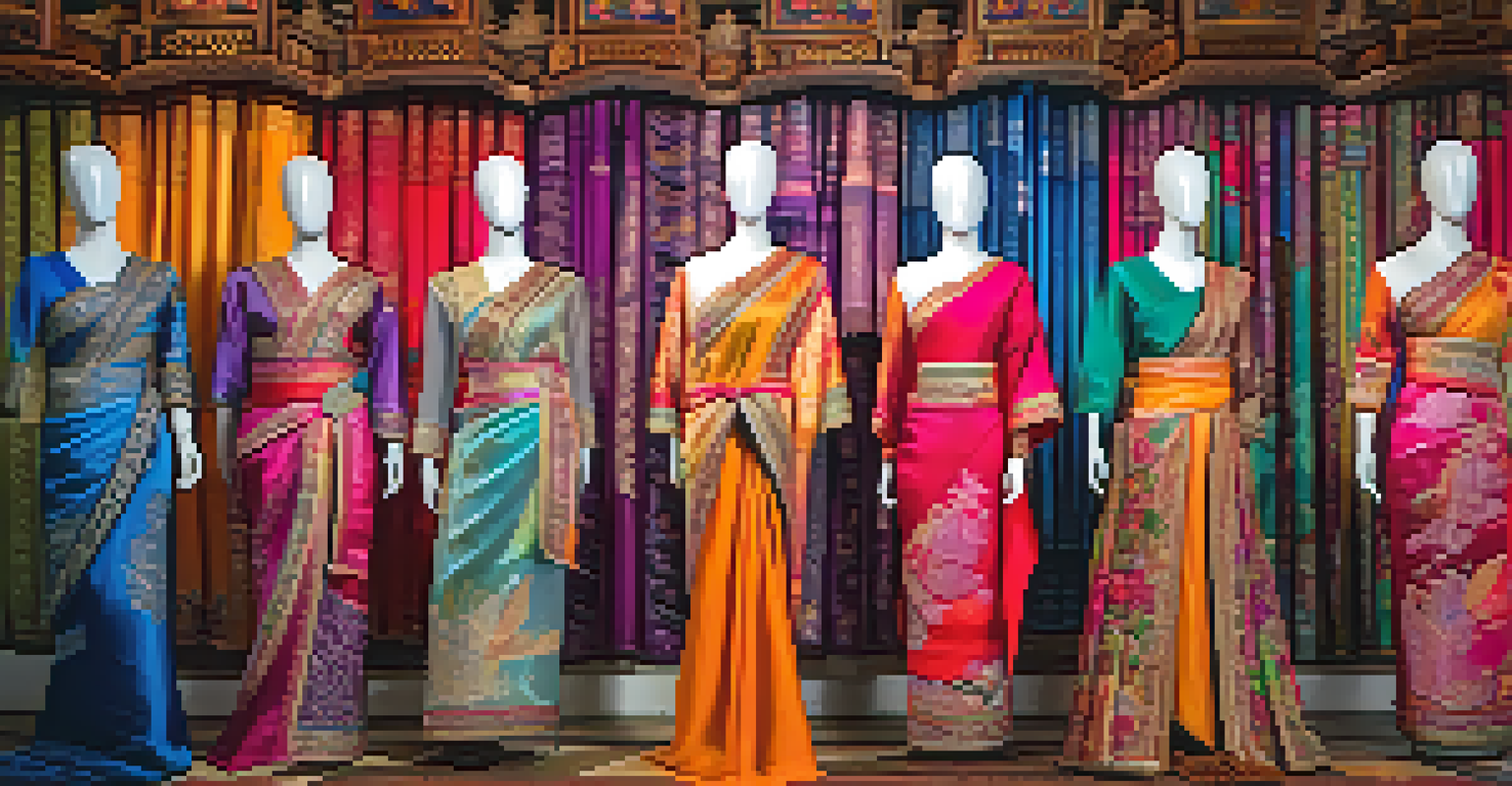Exploring the Process of Thai Silk Production and Weaving

The Origins of Thai Silk: A Rich Cultural Heritage
Thai silk has a long and storied history that dates back centuries. Originating from the northern regions of Thailand, it is deeply intertwined with the culture and traditions of the local communities. The process of silk weaving is not just an art but a way of life for many families, passed down through generations.
Silk is the most luxurious fabric, and it represents the culture, tradition, and artistry of Thai craftsmanship.
Historically, Thai silk was used in royal garments and ceremonial occasions, symbolizing wealth and prosperity. This rich heritage is reflected in the vibrant colors and intricate patterns found in Thai silk fabrics. Each piece tells a story, showcasing the skills and dedication of the weavers.
Today, Thai silk continues to be a symbol of national pride, attracting tourists and fashion enthusiasts alike. The revival of traditional weaving techniques ensures that this craft remains alive, connecting the past with the present.
Silkworms: The Tiny Creators of Luxurious Fabric
The journey of Thai silk begins with the silkworm, specifically the Bombyx mori. Silkworms feed on mulberry leaves and spin cocoons that are made of silk threads. Each cocoon can produce up to a mile of silk, making these tiny creatures vital to the silk production process.

Farmers carefully cultivate these silkworms, monitoring their growth and health. Once the silkworms have completed their metamorphosis, the cocoons are harvested. This delicate process requires skill to ensure that the silk remains intact and usable for weaving.
Cultural Heritage of Thai Silk
Thai silk weaving is a rich tradition that connects local communities and showcases their cultural heritage.
The quality of silk produced depends significantly on the care given to the silkworms, highlighting the importance of sustainable farming practices. This connection between nature and craftsmanship is what sets Thai silk apart from other fabrics.
Harvesting and Processing Silk: A Labor of Love
After harvesting the cocoons, the next step is boiling them to soften the silk. This allows the threads to be unwound carefully without damaging the delicate fibers. It’s a meticulous process, requiring patience and precision to ensure that the silk strands remain smooth and intact.
Fashion is the armor to survive the reality of everyday life, and Thai silk adds elegance to that armor.
Once the threads are extracted, they are cleaned and dyed using both natural and synthetic dyes. Traditional methods often involve plant-based dyes, producing vibrant colors that are unique to Thai silk. This not only enhances the beauty of the fabric but also reflects the artisans' respect for nature.
The processing of silk is a time-consuming endeavor, but it’s essential for achieving the luxurious quality that Thai silk is known for. Each stage, from boiling to dyeing, contributes to the final product and showcases the skill and artistry involved.
Weaving Techniques: Crafting Art from Threads
Once the silk threads are ready, the weaving process begins. Traditional Thai weaving often employs a handloom, where skilled artisans create intricate patterns and designs. This craftsmanship requires years of practice and a keen eye for detail, making each piece truly unique.
Different regions in Thailand have their own distinct weaving styles, which are often influenced by local culture and traditions. For example, the Ikat technique involves dyeing the threads before weaving, creating stunning patterns that tell a story. These variations add depth to the rich tapestry of Thai silk.
Sustainable Practices in Silk Production
The Thai silk industry is increasingly adopting sustainable farming and dyeing methods to meet consumer demand for eco-friendly products.
The artistry in Thai silk weaving is not merely about function; it's about storytelling and cultural expression. Each piece of fabric carries the heritage of its maker, transforming simple threads into works of art that can be cherished for generations.
The Role of Women in Thai Silk Weaving
Women play a pivotal role in the Thai silk industry, often being the primary weavers and caretakers of this craft. Many women in rural communities rely on silk weaving as a source of income, empowering them and providing for their families. This not only supports the local economy but also preserves traditional skills.
Through weaving, women pass down stories and techniques to younger generations, ensuring that this cultural heritage remains vibrant. Their dedication and craftsmanship are evident in the quality of the silk they produce, serving as a testament to their talent and hard work.
Moreover, the increase in demand for Thai silk has opened up new opportunities for women, allowing them to expand their roles beyond traditional confines. This movement towards empowerment through silk weaving is reshaping communities and fostering independence.
Sustainability in Thai Silk Production
Sustainability is becoming increasingly important in the Thai silk industry, as consumers demand eco-friendly practices. Many producers are now focusing on organic farming methods for silkworm cultivation and dyeing processes that are less harmful to the environment. This shift not only benefits the planet but also enhances the quality of the silk.
By prioritizing sustainability, Thai silk producers are preserving the delicate ecosystem that supports silkworm farming. This commitment to ethical practices not only appeals to environmentally-conscious consumers but also helps safeguard the traditions and livelihoods of local communities.
Empowerment Through Weaving
Women play a crucial role in the Thai silk industry, using their skills to support their families and preserve traditional craftsmanship.
As the world becomes more aware of sustainable fashion, Thai silk stands out as an example of how traditional practices can align with modern values. The future of Thai silk not only looks promising but also sets a standard for responsible production in the textile industry.
Thai Silk in Fashion: A Timeless Appeal
Thai silk has made its mark in the fashion world, captivating designers and consumers alike with its elegance and versatility. From haute couture to everyday wear, silk garments are cherished for their luxurious feel and unique patterns. Designers often incorporate Thai silk into their collections, celebrating its heritage and craftsmanship.
The timeless appeal of Thai silk lies in its ability to blend traditional techniques with modern fashion. Whether it's a stunning evening gown or a chic scarf, each piece tells a story of artistry and culture. This fusion of old and new ensures that Thai silk remains relevant and desirable in today’s fashion landscape.

As sustainability becomes a key focus in the fashion industry, the demand for ethically-produced Thai silk is on the rise. Consumers are increasingly seeking out unique, high-quality fabrics that not only look good but also support sustainable practices.